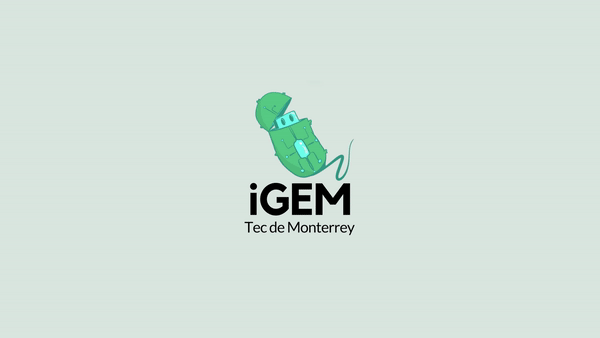EstebanDLPT (Talk | contribs) m |
EstebanDLPT (Talk | contribs) m |
||
| Line 81: | Line 81: | ||
</div> | </div> | ||
<div class="main-info"> <!-- Tercero --> | <div class="main-info"> <!-- Tercero --> | ||
| − | <img | + | Hybrid RNA-ssDNA molecule which contains the message of interest. |
| + | <br> | ||
| + | This message has a PAM sequence, a crucial component for the identification by the CRISPR-Cas complex. | ||
| + | <img src="https://static.igem.org/mediawiki/2018/7/7a/T--Tec-Monterrey--Design_Scribe2.png"> | ||
</div> | </div> | ||
<div class="main-info"> <!-- Quinto --> | <div class="main-info"> <!-- Quinto --> | ||
Revision as of 19:24, 17 October 2018

Overview
CRISPR-Cas technology has the capability of storing information. This year, iGEM team Tec-Monterrey aims to use the CRISPR-Cas system to store specific DNA sequences in the genome of E. coli in order to save information about the environment surrounding the bacteria. To make this possible, Cas1-Cas2 proteins, which create the protospacer acquisition in the CRISPR system, are used to insert a synthetic DNA sequence in the CRISPR array within the genome of the bacteria. This synthetic sequence is produced by a second system, called SCRIBE. The final step of our project is reading out the inserted DNA sequence. Specific primers for polymerase chain reaction (PCR) are used to amplify a section of the CRISPR array where the sequence is inserted. Taking together both systems, our project intends to act as a biological tape recorder capable of sensing external stimuli in the environment and storing their presence in the genome.
System Functionality
Construct that codes for the SCRIBE system adaptation.
This system generates single-stranded DNA inside of living cells in response to gene regulatory signals.
It is composed of 3 main components:
This system generates single-stranded DNA inside of living cells in response to gene regulatory signals.
It is composed of 3 main components:
- A reverse transcriptase protein
- One msr RNA moiety which acts as a primer for the RT.
- A second RNA moiety, called msd, which represents a template for the reverse transcriptase. This sequence contains the message of interest.

Hybrid RNA-ssDNA molecule which contains the message of interest.
This message has a PAM sequence, a crucial component for the identification by the CRISPR-Cas complex.
This message has a PAM sequence, a crucial component for the identification by the CRISPR-Cas complex.



The retrotranscriptase acts on the msd (RNA) sequence and produces a hybrid RNA-ssDNA molecule called msDNA.




References
Amlinger, L., Hoekzema, M., Wagner, E. G. H., Koskiniemi, S. & Lundgren, M. Fluorescent CRISPR Adaptation Reporter for rapid quantification of spacer acquisition. (2017).doi: 10.1038/s41598-017-10876-z.
Díez-Villaseñor, C., Guzmán, N. M., Almendros, C., García-Martínez, J. & Mojica, F. J. M. CRISPR-spacer integration reporter plasmids reveal distinct genuine acquisition specificities among CRISPR-Cas I-E variants of Escherichia coli. RNA Biol. (2013). doi:10.4161/rna.24023
Farzadfard, F., & Lu, T. K. Genomically encoded analog memory with precise in vivo DNA writing in living cell populations. Science. (2014). doi: 10.1126/science.1256272.
Levy, A., Goren, M. G., Yosef, I., Auster, O., Manor, M., Amitai, G., Edgar, R., Qimron, U. & Sorek, R. CRISPR adaptation biases explain preference for acquisition of foreign DNA. Nature. (2015). doi:10.1038/nature14302
Nuñez, J. K. Mechanism of CRISPR–Cas Immunological Memory. (2016). Doctoral dissertation, UC Berkeley
Nuñez, J. K., Kranzusch P, Noeske J, Wright A, Davies C, Doudna J. Cas1-Cas2 complex formation mediates spacer acquisition during CRISPR-Cas adaptive immunity. Nat. Struct. Mol. Biol. (2014). doi:10.1038/nsmb.2820
Sheth, R. U., Yim, S. S., Wu, F. L. & Wang, H. H. Multiplex recording of cellular events over time on CRISPR biological tape. Science. (2017). doi:10.1126/science.aao0958
Shipman, S. L., Nivala, J., Macklis, J. D., & Church, G. M. Molecular recordings by directed CRISPR spacer acquisition. Science. (2016). doi: 10.1126/science.aaf1175
Tang, W., & Liu, D. R. Rewritable multi-event analog recording in bacterial and mammalian cells. Science. (2018). doi: 10.1126/science.aap8992


